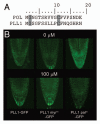The role of the acyl modification, palmitoylation, in Arabidopsis stem cell regulation
- PMID: 21460611
- PMCID: PMC3115195
- DOI: 10.4161/psb.5.8.12409
The role of the acyl modification, palmitoylation, in Arabidopsis stem cell regulation
Abstract
Proper control of stem cell populations is key for the development of all multicellular organisms. In Arabidopsis, stem cells are located primarily in the shoot, root and floral meristems where they undergo complex regulation. The Arabidopsis shoot and root meristems are regulated by the related WUS and WOX5 pathways, respectively. Previous studies established that these pathways share the signal transduction components POLTERGEIST (POL) and PLL1. Our latest study in Plant Cell revealed key roles for acyl modifications and lipid binding in the regulation of these two type 2C protein phosphatases. Specifically, POL and PLL1 were shown to localize to the plasma membrane in a myristioylation- and palmitoylation-dependent manner, POL and PLL1 were shown to bind to membrane lipids, and POL activity was found to be stimulated in vitro by the phospholipid PI(4)P. Here, we will discuss what is currently known in Arabidopsis and other organisms about the mechanisms of palmitoylation and provide additional evidence supporting that POL and PLL1 are palmitoylated, including describing the identification of a putative Arabidopsis palmitoyl transferase as a PLL1 interactor.
Figures


Comment on
-
The Arabidopsis stem cell factor POLTERGEIST is membrane localized and phospholipid stimulated.Plant Cell. 2010 Mar;22(3):729-43. doi: 10.1105/tpc.109.068734. Epub 2010 Mar 26. Plant Cell. 2010. PMID: 20348433 Free PMC article.
Similar articles
-
The Arabidopsis stem cell factor POLTERGEIST is membrane localized and phospholipid stimulated.Plant Cell. 2010 Mar;22(3):729-43. doi: 10.1105/tpc.109.068734. Epub 2010 Mar 26. Plant Cell. 2010. PMID: 20348433 Free PMC article.
-
POLTERGEIST and POLTERGEIST-LIKE1 are essential for the maintenance of post-embryonic shoot and root apical meristems as revealed by a partial loss-of-function mutant allele of pll1 in Arabidopsis.Genes Genomics. 2020 Jan;42(1):107-116. doi: 10.1007/s13258-019-00894-8. Epub 2019 Dec 3. Genes Genomics. 2020. PMID: 31797316
-
Key divisions in the early Arabidopsis embryo require POL and PLL1 phosphatases to establish the root stem cell organizer and vascular axis.Dev Cell. 2008 Jul;15(1):98-109. doi: 10.1016/j.devcel.2008.05.008. Dev Cell. 2008. PMID: 18606144 Free PMC article.
-
Coming into bloom: the specification of floral meristems.Development. 2009 Oct;136(20):3379-91. doi: 10.1242/dev.033076. Development. 2009. PMID: 19783733 Review.
-
Core pathways controlling shoot meristem maintenance.Wiley Interdiscip Rev Dev Biol. 2013 Sep-Oct;2(5):671-84. doi: 10.1002/wdev.110. Epub 2013 Feb 27. Wiley Interdiscip Rev Dev Biol. 2013. PMID: 24014453 Review.
Cited by
-
A complex systems approach to Arabidopsis root stem-cell niche developmental mechanisms: from molecules, to networks, to morphogenesis.Plant Mol Biol. 2012 Nov;80(4-5):351-63. doi: 10.1007/s11103-012-9954-6. Epub 2012 Sep 4. Plant Mol Biol. 2012. PMID: 22945341 Review.
References
-
- Sarkar AK, Luijten M, Miyashima S, Lenhard M, Hashimoto T, Nakajima K, et al. Conserved factors regulate signalling in Arabidopsis thaliana shoot and root stem cell organizers. Nature. 2007;446:811–814. - PubMed
-
- Song SK, Clark SE. POL and related phosphatases are dosage-sensitive regulators of meristem and organ development in Arabidopsis. Dev Biol. 2005;285:272–284. - PubMed
Publication types
MeSH terms
Substances
Grants and funding
LinkOut - more resources
Full Text Sources
Medical
Molecular Biology Databases
Research Materials
Miscellaneous
